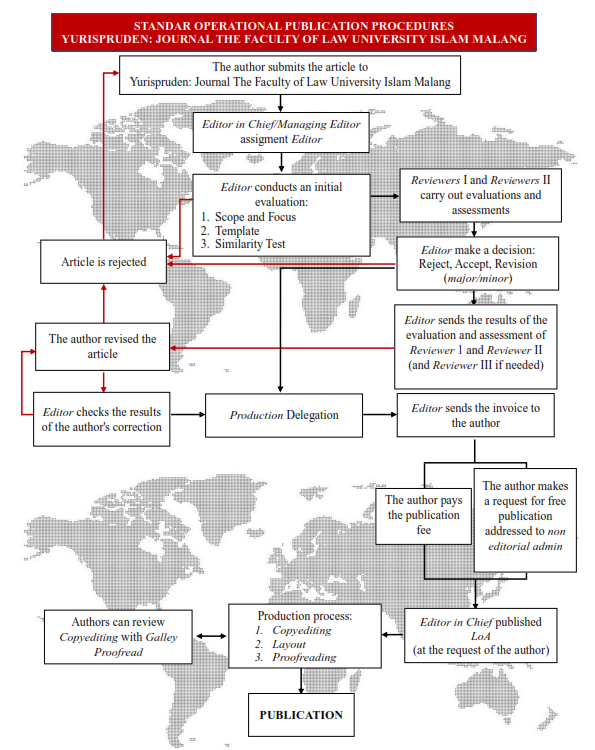| FOCUS AND SCOPE |
| EDITORIAL TEAM |
| PEER REVIEW PROCESS |
| PUBLICATION ETHIC |
| PLAGIARISM POLICY |
| PRIVACY STATEMENT |
| ARTICLE PUBLICATION CHARGES |
General Requirements
Spesific Requirements
Title (Times New Roman, 16, Bold, 1 Space, Center, Capitalized Case)
The title is written concisely, describing the value of the novelty of the research and the number of words for the title is no more than 15 words.
Author Name, Author Affiliation (Times New Roman, 12, 1 Space, Center, Capitalized Case)
Author's name is written in full without academic title and position, lecturer affiliation consists of: study program name, faculty name, university name, and university's full address, as well as the correspondent author's email. Author affiliations other than lecturers and addresses adjust.
Abstract (Times New Roman 12, Bold, 1 Space, Capitalized Case)
Abstract contains: (1). Background (brief); (2). Research objectives and/or scope; (3). The method used (brief); (4). Summary of results/findings; (5). Conclusion. Abstracts are written in Indonesian and English using a 12px font. Times New Roman. Abstract does not exceed 150 words. Abstract is written using 1 space. Manuscripts written in Indonesian begin with an abstract (abstract in English), manuscripts written in English begin with an abstract (abstract in Indonesian). Abstract consists of only 1 paragraph. Abstract accompanied by 3-5 keywords that represent the contents of the manuscript.
Introduction (Times New Roman 12, Bold, Upper Case)
The introduction consists of 6 paragraphs, and each paragraph consists of 3-5 sentences. The first paragraph describes the relevant general background, philosophical basis, juridical basis and/or sociological basis which is relevant to the research. The second paragraph describes the state of the art (literature review of previous similar studies) which is the basis for justifying contributions, and the novelty of the research, (there must be a gap analysis) followed by a novelty statement (conclusion of similarities and differences with previous research). The third paragraph contains the urgency of the research, fourth paragraph the legal issues/issues that are the focus of the research, fifth paragraph the research methods used and sixth paragraph the research objectives written in a straightforward and clear manner (not using the sentence: "Based on this background, the purpose of this research...).
Writing the beginning of the sentence for each paragraph in the text is indented to the right 5 beats, with 1.5 spacing, 12px font. Times New Roman. Formulation of legal problems/issues is written in paragraph format, not using numbering or bullets.
Results and Discussion (Times New Roman 12, Bold, Upper Case)
The results and discussion chapter does not contain conceptual definitions, points, descriptions of types, descriptions of various concepts, complete excerpts of articles and/or paragraphs, and raw data. The results and discussion chapter contains at least: (1). The what/how element in the form of a table/figure (choose one) accompanied by a name at the top of the table and an explanation of the table data. This section also describes the findings after the table. (2). The why element describes the relationship between the findings (research results) and the basic concepts and/or hypotheses. The discussion must be supported by real and clear facts. (3) the what else element describes the suitability and/or conflict with other studies. Each element section can consist of several paragraphs, but there must be a difference from one element to another.
Each answer to the legal problem/issue formulated is discussed in a different sub-chapter, with 1.5 spacing, 12px font. Times New Roman. Writing the beginning of the sentence of each paragraph is thrust to the right 5 beats.
Conclusion (Times New Roman 12, Bold, Upper Case)
The conclusion contains a brief answer to the problem, emphasizes novelty and research urgency, (does not contain new descriptions/discussions).
Conclusions can be made in paragraph form and do not use numbering or bullets. Many conclusions are adjusted to the number of problem formulations. The conclusion consists of 1 paragraph.
Suggestions (if any) (Times New Roman 12, Bold, Upper Case)
Authors should provide suggestions (recommendations) that are relevant to relevant legal issues/issues. Suggestions can be made in paragraph form without using numbering or bullets.
Bibliography (Times New Roman 12, Bold, Upper Case)
The bibliography is classified into journals and proceedings (primary libraries), as well as other libraries sourced from the internet, theses/thesis/dissertations or books, with a minimum number of 30 bibliography that have been published for no more than 5 years. The primary library is at least 80% of the total library used. Names in the bibliography are written without title and academic position. The list of references that is loaded is the one cited in the manuscript. Jurisprudence: Journal of the Faculty of Law, Islamic University of Malang uses the Chicago Manual of Style 17th Edition (full note) in writing references arranged alphabetically, and the author is required to use  . For more complete information, see the template. Templates can be download in
. For more complete information, see the template. Templates can be download in  .
.

Authors who publish this journal agree to the following terms:
The author retains the copyright to the article published in Yurispruden: Jurnal Fakultas Hukum Universitas Islam Malang, but grants publish rights to Yurispruden: Jurnal Fakultas Hukum Universitas Islam Malang to publish and disseminate the author's article.
The publication and dissemination of the article is subject to an attribution license (CC BY) under the Creative Commons Attribution License, so that others free also to copy, and redistribute the material in any medium or format, remix, transform and build upon material for any purpose, even commercially, as long as they give credit to the author for the authentic work.
Names and emails entered in this Yurispruden: Jurnal Fakultas Hukum Universitas Islam Malang will specifically be used for the purpose of publishing articles in thisYurispruden: Jurnal Fakultas Hukum Universitas Islam Malang, not for other purposes.
| PLAGIARISM CHECKER |

| SUPPORT BY |

Yurispruden: Jurnal Fakultas Hukum Universitas Islam Malang by Fakultas Hukum Universitas Islam Malang is licensed under CC BY 4.0
